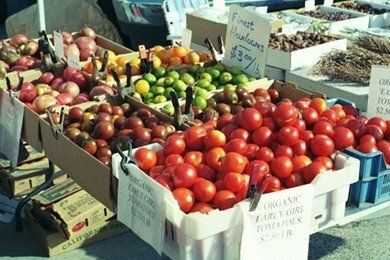How To Find Great Fruit and Veggies
March 31, 2010 9 Comments
Are you tired of buying expensive fruit that tastes crappy? What can you do to ensure that the fresh food you buy is really delicious?

Snack-Girl's readers are a wonderful bunch (love you guys!). Every once in a while, I get a request about healthy eating. Here is Krissy's:
I recently moved to Chicago from Los Angeles. It probably goes without saying that produce here just isn't the same. I'm currently very interested in how to tell which fruit is the ripest, freshest, etc. I really took this for granted back home!
Yes, Krissy, I feel ya. Having recently moved from San Francisco to Massachusetts, I, too, am feeling the sting of the lack of a year round and local source of fresh produce. BUT, there are up sides in living in a seasonal zone.
Now that you live in Chicago, you get the excitement that comes with Spring! Right now, at every major supermarket, artichokes and asparagus are cheap and fresh. Soon, fresh strawberries will arrive, followed by such goodies as fresh tomatoes and corn. Aaaah.
There are many answers to your question - how do I tell if my produce is fresh?
1. Start a garden
Okay, this is not a practical answer for many people - BUT - you will know that your produce is fresh :)
2. Find a Farmer's Market
This will only work for 4-5 months out of the year, but it is a great way to get fresh food in Chicago or anywhere else for that matter. The photo above was taken at a San Francisco Farmer's Market and the fruit and produce there is incredible! sob...
Here is a great website for locating farmer's markets: Local Harvest. I found 57 listings near Chicago, IL.
A few things you know - first, it won't NECESSARILY be cheaper than the supermarket. I bought a peach that cost me $3 once. It was one of the best damn peaches that I have ever eaten - but it was not cheap. If you are looking for a deal, a Farmer's Market may not be the right place.
Secondly, even Farmer's Market's have crappy produce. Try a few different farmers before you settle on which one is the best. Write down the names of the farms or farmers that you visit so you will remember which one you visited. Talk to the farmer about their methods - they may not have an "organic" sign - but they still may be using organic methods.
3. Try a CSA
A CSA is Community Supported Agriculture and can also be found on Local Harvest. The farmer ships produce directly to you and it reduces the time it takes to get the produce - therefore it is fresher.
We had one in San Francisco, and every 2 weeks would receive a box of produce from a farm near the city. CSA's can be expensive - but, if you can find someone who can share it with you - CSA's are a great way to get fresh food.
4. Get to know the seasons for your fruits and veggies
For example, oranges are a winter fruit. If you buy oranges in the winter, your chances of getting a fresh one from Florida or California go up quite a bit.
My favorite source for individual fruit and veggie seasons is Mark Bittman's cookbook, "How to Cook Everything". It has a great list of produce with recipes for the best way to serve them.
5. Get to know your local supermarkets
I have gone to FIVE different markets to find which ones had the best (and cheapest) produce. I have a Whole Foods, Stop-n-Shop, Big Y, local produce market, etc. and I tried all of them before I settled on one that I count on for most of produce when the winter is in full swing. It just takes time to find the freshest stuff and to learn that a strawberry in December is going to be crappy wherever I buy it.
Below are two great books on seasonal fresh produce and local food.

How to Cook Everything: 2,000 Simple Recipes for Great Food,10th Anniversary Edition
$35.00 $28.88 Buy on Amazon.com
As an Amazon Associate, I earn from qualifying purchases.
How do you find great produce?
Want to read about snacks?
One Sweet Reason To Avoid Artificial Sweeteners
No-Bake, Nut Butter, Oatmeal Cookie
Love Ice Cream? Try This 130 Calorie Makeover
The Worst Pizza on the Planet


9 Comments:
Candice
stan
disco dotty
myrna
Jenn @ Watch My Butt Shrink!
Kitchen Monki Dan
Alta
krissy
Lyn